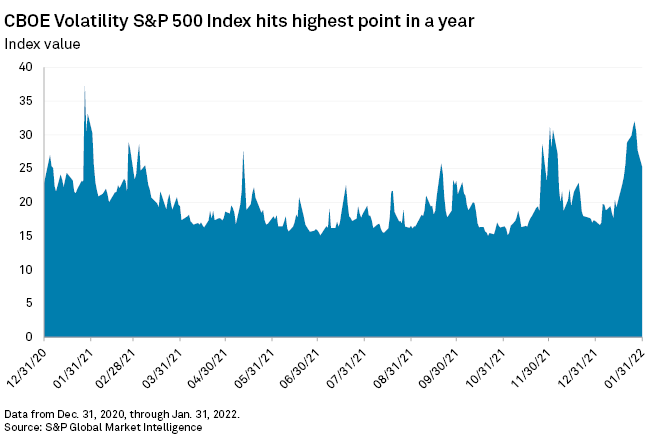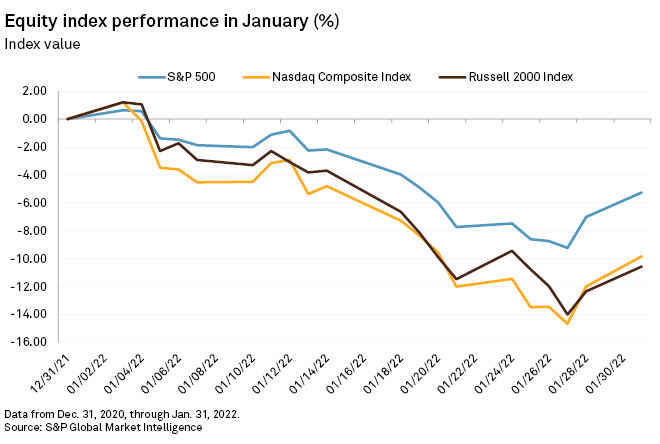Investors got a rude awakening in January as the S&P 500 hit a record high, fell into a correction and then briefly rallied before ending the month down 5.3%, a sign that equities will be far more choppy in 2022 than they were in 2021.
"The year will be volatile," said Steve Deppe, chief investment officer at Nerad + Deppe Wealth Management.
The S&P 500 fell 9.8% from its all-time high settlement on Jan. 3 to its Jan. 27 settlement, its lowest close since Oct. 4. While the S&P 500 did rally about 4.4% in the last three trading days of January, the 5.3% decline marked the index's worst month since March 2020 and its worst January since 2008.
The S&P 500 climbed throughout much of 2021, ending up 26.9% on the year. The index gained ground in nine months in 2021.

The Cboe Volatility Index, or VIX, settled near 32 on Jan. 26, its highest point settlement since Feb. 1, 2021. The index represents market expectations for volatility during the next 30 days.
"I think we're overdue for some regular volatility," said Ryan Detrick, chief market strategist at LPL Financial. "It feels shocking to investors because we've been so spoiled for almost two years now."

The average spread between the S&P 500's daily highs and lows, another measure of market volatility, was 2.06% in January and reached 4.61% on Jan. 24, according to Howard Silverblatt, a senior index analyst with S&P Dow Jones Indices. That spread averaged 0.97% in 2021, Silverblatt said.
Ten of the S&P 500's 11 sectors lost ground in January, with consumer discretionary stocks faring the worst, losing 9.7% on the month. The energy sector was the lone success story in January as it climbed nearly 19%, largely due to high global oil prices.

The S&P 500, tech-heavy Nasdaq composite index and the small-cap Russell 2000 all dipped into a correction in January, typically defined as a 10% drop from a recent high.
The weakness, analysts said, was due to a combination of factors, including: the Federal Reserve's plans to hike rates throughout 2022; soaring inflation and persistent supply chain constraints; fears of omicron and other coronavirus variants; and geopolitical issues.
"It's a perfect storm of selling with the Fed set to raise rates, supply chains remain under major constraints, and tech [work-from-home] favorites such as Netflix Inc., Zoom Video Communications Inc. and Peloton Interactive Inc. have fallen off a cliff with soft numbers and risk-off mentality on the Street," said Daniel Ives, managing director, equity research at Wedbush Securities. "The stock market has seen a meteoric rise from the COVID March 2020 lows and now the Fed is crashing the tech party with inflation rising globally."
Market volatility began to boil over Jan. 5 after the Fed released minutes of its December 2021 meeting, which showed that central bankers were preparing a rate hike at their March meeting and a sooner-than-expected reduction of its roughly $9 trillion balance sheet.
"I think that was the reality check that the market first took to realize that the Federal Reserve was going to prioritize fighting inflation with a bit more of a hawkish tone than what was previously expected," said Deppe with Nerad + Deppe. "Anytime the market experiences a volatility earthquake of this magnitude, it's always driven by tremendous uncertainty in future expectations."
Further equity declines are likely while the Fed contemplates how quickly it plans to tighten monetary policy.
"Until there's Fed clarity, we do not see this market being able to approach the old highs or set new highs," wrote Tom Essaye, a trader and founder of Sevens Report, in a Jan. 31 note.
S&P Dow Jones Indices and S&P Global Market Intelligence are owned by S&P Global Inc.



